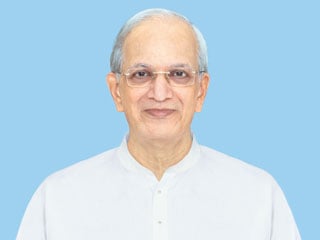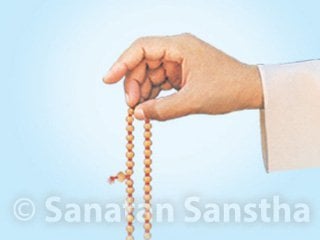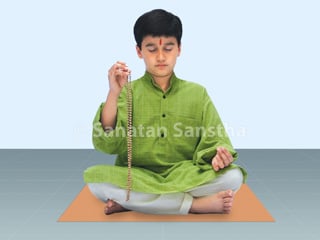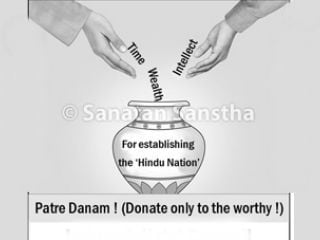Reason why Gurukrupayoga has been created through the
medium of Paratpar Guru (Dr.) Athavale, and the associated process

As of now there are many established Paths of Yoga (Spiritual practice) such as Dnyanyoga (Path of knowledge), Karmayoga (Path of action), Bhaktiyoga (Path of devotion), Dhyanyoga (Path of meditation), Hathayoga (Path of deliberate rigour), Namsankirtanyoga (Path of chanting the Name of God), Kundaliniyoga (Path of activation of spiritual energy), Shaktipatyoga (Path of self-realisation by transmission of spiritual energy from the Guru) etc. By the grace of Sant Bhaktaraj Maharaj – The Seat of faith of Sanatan Sanstha – Paratpar Guru (Dr.) Athavale (Founder of Sanatan Sanstha) propounded Gurukrupayoga (Path of Guru’s grace) in 1994.
Importance of Gurukrupayoga when compared with
other Paths of Yoga and unique features of Gurukrupayoga
1. A confluence of various Paths of Yoga
Gurukrupayoga is a beautiful confluence of all the Paths of Yoga such as Dnyanyoga, Karmayoga, Bhaktiyoga, Dhyanyoga, Hathayoga, Namasankirtanyoga, Kundaliniyoga, Shaktipatyoga etc. As a result, whoever follows Gurukrupayoga gets the benefit of all the other Paths of Yoga and his sadhana (Spiritual practice) attains completeness.
2 . Acts as per various Paths of sadhana and Gurukrupayoga
1. Bhaktiyoga
1A. Karmakanda
1A 1. Actions in sadhana as per Gurukrupayoga
1A 1A. Performing Yadnyas (Sacrificial fires) for Deities, havan and pujas : To protect seekers and Paratpar Guru (Dr.) Athavale from the attack of negative energies operating in the subtle, and also to eliminate the subtle obstacles in the vyashti and samashti sadhana of the seekers, Sanatan’s seeker-priests are performing Yadnyas (Sacrificial fires) to appease specific Deities, havan and specific pujas (Religious rituals) as advised by different Saints, astrologers and Maharshis, as well as readers of Nadipatti from time to time.
1A 1B. Visiting an awakened temple, having the darshan of the Deity and performing Abhishek for the Deity : At times, on behalf of Sanatan Sanstha seekers have the darshan of Deities in specific temples that are known to be awakened places and at other times, they perform Abhishek (Consecration by ritualistic bathing with water, milk etc.) and seek blessings.
1A 1C. Casting off the evil eye and keeping the utara : To overcome the evil eye or the effect of karni (Black magic) on seekers, the evil eye is cast off as advised in the Scriptures, and utaras are kept for the negative energies that are causing distress to them.
1B. Upasanakanda
1B 1. Actions in sadhana as per Gurukrupayoga
1B 1A. Performing an action with bhav : While chanting, performing seva and actions under vyashti & samashti sadhana, seekers try to do all these with as much bhav as possible.
1B 1B. Making efforts to enhance bhav as advised in the bhav-satsang : By attending and practicing the points shared in the weekly national level bhav-enhancing satsang, the seekers try to enhance bhav.
1B 1C. Performing manas-puja and manas- Namaskar : Seekers are taught to perform manas-puja (Mental worship) instead of actual puja, perform manas- Namaskar (Obeisance) instead of actual Namaskar etc.
1B 1D. Making efforts to increase prembhav (Emotion of love) and Priti (Unconditional love) : Seekers make daily efforts to increase prembhav and Priti in themselves so that they can reach a stage where they feel ‘the entire world is my home’.
1B 2. Karmayoga
1B 2A. Actions in sadhana as per Gurukrupayoga
1B 2A 1. Satseva and sacrifice under vyashti sadhana : As a part of their vyashti sadhana, seekers perform satseva and sacrifice.
1B 2A 2. Performing seva unto the Nation and Dharma under samashti sadhana : As a part of their samashti sadhana, seekers perform the sevas of disaster management, participate in various movements and agitations and thereby, render seva unto the Nation and Dharma.
1B 3. Dnyanayoga
1B 3A. Actions in sadhana as per Gurukrupayoga : By becoming introverted, seekers study the mistakes they commit at the physical, mental, intellectual and ego level, implement the Personality Defect Removal and Ego Removal Process, and try to make it increasingly effective.
1B 4. Dhyanayoga
1B 4A. Actions in sadhana as per Gurukrupayoga
1B 4A 1. Making efforts in sadhana with concentration: Seekers try to chant, perform seva and other aspects of their sadhana with concentration.
1B 4A 2. Saints meditate : Some of Sanatan’s Saints meditate while chanting and thus, perform spiritual remedies for the seekers.
1B 5. Tantramarg
1B 5A. Actions in sadhana as per Gurukrupayoga :
While chanting and performing spiritual remedies, seekers perform aspects such as ‘creating a protective sheath around themselves of vibhuti or water mixed with vibhuti, doing nyas and making mudra at locations on their body where they experience distress while chanting and praying for creation of a protective sheath around themselves. Seekers also wear Yantras (A device / shape which represents a Deity) of various Deities such as Shriyantra, Mrutyunjayayantra etc. that have been charged by Saints.
1B 6. Kundaliniyoga
1B 6A. Actions in sadhana as per Gurukrupayoga : To awaken the Kundalinishakti of the seekers and to protect the Kundalinichakras from negative energy attacks, seekers are advised to wear pictures of various Deities or their Name-strips on their saptachakras. This is advised as a measure of spiritual remedy and as per the need of the time.
1B 7. Shaktipatyoga
1B 7A. Actions in sadhana as per Gurukrupayoga : To eliminate the spiritual distress of some seekers, some Saints have performed eye-remedies, hand-remedies, mudra-remedies etc. on the seekers and thus diverted the flow of Divine Energy active in their bodies towards the seekers.
1B 8. Namasan-kirtanyoga
1B 8A. Actions in sadhana as per Gurukrupayoga
1B 8A 1. Chanting the Name of the Family Deity and Deity Datta : Seekers in the preliminary stages of sadhana chant the Name of their Family Deity upon commencing sadhana, and depending on the distress caused by the departed ancestors, chant 3, 6 or 9 malas of Deity Datta’s Name depending on the severity of their distress.
1B 8A 2. While performing sadhana that is the need of the times, chanting the Name of a specific Deity for a specific period : The seekers who have been performing sadhana for a long time, do not chant the Name of a particular Deity; instead, while performing sadhana as per the need of the times, chant the Name of a specific Deity for a specific period. For example, now the seekers are chanting ‘Om Namo Bhagawate Vasudevaya I’ since it is the need of the prevailing times.
1B 8A 3. Chanting the Name of various Deities, numbers and Principles as per the process of elimi-nation of ailments and Pranashakti flow system : During the spiritual remedies performed as per the process of ‘Elimination of ailments and Pranashakti flow system’, chanting the Names of various Deities, numbers, Principles etc. is done.
1B 9. Mantrayoga
1B 9A. Actions in sadhana as per Gurukrupayoga : For curing ailments and getting rid of spiritual distress, Saints recite mantras or hymns of various Deities, and the seekers listen to them with faith and bhav.
1B 10. Mixed
1B 10A. Actions in sadhana as per Gurukrupayoga : Seekers try to inculcate and develop various virtues in themselves.
1 C. The sadhana advised as per Gurukrupayoga is easy to understand when compared with other Paths of Yoga : The common man in Kaliyuga finds it difficult to perform acts such as reading various Holy texts as per Dnyanayoga and understand their implied meaning as per the sadhana in the Path of Dnyanayoga, going to a forest and meditating or taking up a specific sitting posture and achieving a meditative state, performing nishkam karma etc. as part of their sadhana.
Conversely, the sadhana as per Gurukrupayoga advised by Sanatan Sanstha can be performed by any spiritually curious individual and mumukshu (One with intense desire for God-realisation) irrespective of his age, gender, region, language, caste, sect or country. This sadhana does not even depend on the financial status and education of the individual. Therefore, the sadhana advised as per Gurukrupayoga is easy to understand and practice for everyone.
1 D. Sanatan’s treasure of Holy texts is a feather in the cap of Gurukrupayoga : Till January 2017, Sanatan has published 71 lakh 42 thousand copies of 306 Holy texts in 17 languages. Sanatan’s treasure of Holy texts is the fifth Veda and one that revives knowledge in Kaliyuga. Gurukrupayoga propounded by Paratpar Guru (Dr.) Athavale and His invaluable teachings are going to be eternal in the form of these Holy texts. Sanatan’s treasure of Holy texts is a feather in the cap of Gurukrupayoga propounded by Paratpar Guru (Dr.) Athavale. This Path of spiritual practice advises the seekers performing sadhana as per different Paths of Yoga to connect their Path to Gurukrupayoga and progress fast spiritually.
1 E. Conducive to the seekers on the Paths of pravrutti (Participation in worldly affairs) as well as nivrutti (Cessation of participation in worldly affairs) : Sadhana advised by Sanatan Sanstha is conducive to and supportive for seekers who are following the Path of pravrutti, meaning, performing sadhana while continuing to lead a worldly life as well as those following the Path of nivrutti, meaning, those who perform sadhana after cessation of participation in worldly affairs. Therefore, the seekers following both the Paths are attracted towards sadhana advised as per Gurukrupayoga.
1 F. Teaching to perform sadhana while continuing to lead a worldly life : Some sects advise performing of sadhana by renouncing family life and adopting the life of an Ascetic. Conversely, in Sanatan Sanstha, without any type of compulsion, seekers are taught how to perform sadhana in a manner that it takes place naturally. In sadhana as per Gurukrupayoga, human life has two goals – To exhaust the suffering arising out of prarabdha (Destiny that is experienced in this birth) and performing sadhana for attaining Moksha (The Final Liberation). ‘Birth, marriage and death of human beings’ are a culmination of the individual’s prarabdha. Hence, the seekers who perform sadhana as per Gurukrupayoga are advised to perform sadhana while continuing to lead a family life. Most Sanatan seekers are doing this, while others as per their own wish have renounced family life and are performing full-time sadhana.
1 G. Emphasis on vyashti as well as samashti sadhana : In other sects, importance is given to performing only vyashti sadhana. They are just not aware of aspects such as approaching the society and propagating Dharma or Spirituality, making efforts to stop harm to Dharma, uniting Hindus etc. For attaining Moksha merely performing vyashti or samashti sadhana does not suffice. Hence, it is important to perform both these types of sadhana. Therefore, in Gurukrupayoga advised by Sanatan Sanstha, importance is given to performing samashti sadhana along with vyashti sadhana.
1 H. Preaching sadhana as per Gurukrupayoga without charging any thing : Some organisations charge fees from the spiritually curious and the seekers who approach them for conducting lectures on Spirituality, specific type of sadhana or staying in their Ashram. Sanatan Sanstha does not charge any fee for the lectures, movements, Dharmajagruti Sabhas, workshops or satsangs that it arranges. Sanatan Sanstha actively serves the Nation, Dharma and spread of Spirituality; it accepts advertisements or donations given willingly. There is no compulsion for donations. This is the uniqueness of Sanatan Sanstha.
Therefore, any individual who has spiritual curiosity and yearning does not feel stressed while performing sadhana at the vyashti and samashti level advised by Sanatan Sanstha, even though his financial position may not be all that good and he performs it easily.
1 I. Along with sadhana, keeping sensitivity about the society awakened and teaching to help the society : Every individual is a constituent of the society. Hence, he should be sensitive about the society he is living in and fulfil his social duties. Sanatan Sanstha teaches this. Hence, Sanatan’s seekers, associated Devout Hindus and patriots are always ready to provide people first-aid and other emergency help during natural and man-made disasters. Under the help provided to the society, acts such as distributing clothes, books, fruits and food grains to the needy, cleaning temples, public awareness against corruption, effective use of RTI for the benefit of the Nation and Dharma etc. are taught.
1 J. Teaching patriotism along with sadhana : Under Gurukrupayoga, sadhana to awaken samashti bhav (Thought about spiritual upliftment of the society) is being taught in Sanatan Sanstha. Accordingly, seekers are taught about helping the society, protecting the Nation and bringing about awakening on Dharma. Seekers are taught that, ‘Bharat is the holiest land on the earth. Birth in Bharat is a sign of blessedness. Therefore, while performing sadhana seekers should always nurture patriotism by constantly remaining aware that they are responsible citizens of Bharat’. The seekers are always alert to aspects such as distortion of history and the map of Bharat, denigration of Bharatmata, insult to national heroes, denigration of the National Flag, insult of the National Anthem etc., and take appropriate legal action against the people involved.
1 K. Teaching to abide by Dharma along with sadhana : Under sadhana as per Gurukrupayoga advised by Sanatan Sanstha, the unparalleled importance of Hindu Dharma and abiding by Hindu Dharma is impressed upon the minds of the seekers. Accordingly, Sanatan Sanstha lays greater emphasis on abiding by Dharma and behaving as per the guidelines set by Hindu Scriptures. Therefore, seekers of Sanatan Sanstha apply kumkum & tilak, women do not let their hair loose but tie a bun, women do not wear skirts or jeans but wear salwar-kurta or a sari. Many seekers celebrate Holy and Religious festivals as advised in Hindu Scriptures, perform puja, observe vrats (Vowed religious observances) and perform Yadnyas (Sacrificial fires) by following the same guidelines. The science underlying various steps in abiding by Dharma is being taught in Sanatan Sanstha. As a result, seekers easily note the benefits of abiding by Dharma, and they abide by Dharma willingly besides performing sadhana. ?
– Ms. Madhura Bhosale (Knowledge obtained through the subtle dimension), Sanatan Ashram, Ramnathi, Goa.
Subtle : That which is beyond the visible five sense organs, mind and intellect is ‘subtle’. Individuals who have progressed spiritually are able to comprehend the ‘subtle’ vibrations. There is a mention of ‘subtle’ knowledge in various Scriptures.
Request to religious scholars !
Assist in studying the appropriateness of the unique knowledge being received by Sanatan’s seekers and spiritual experiences they have !
By God’s grace, some Sanatan seekers are receiving knowledge that is not available as yet in the ancient religious texts and Scriptures. Since this knowledge is new and unique, it cannot be compared for appropriateness by referring to the ancient Scriptures. If religious scholars assist and guide us in studying the appropriateness of such new matter as well as unique spiritual experiences (Example – Higher subtle regions, experiences related to the Panchamahabhuta), entire mankind will benefit. Similarly, we will also learn what is inappropriate. We request religious scholars to guide us in this endeavour ! – Editor

 Why do we chant Name of Kuladevi instead of Kuladev?
Why do we chant Name of Kuladevi instead of Kuladev? Remedies for mental illness arising in an emergency
Remedies for mental illness arising in an emergency how to improve mental strength to face a terrible situation such as a riot
how to improve mental strength to face a terrible situation such as a riot Guidance by His Holiness Bhagwantkumar Menrai on how to coordinate chanting the Name of God...
Guidance by His Holiness Bhagwantkumar Menrai on how to coordinate chanting the Name of God... Difference between donation and offering and their importance
Difference between donation and offering and their importance Do not feel scared by the increasing coronavirus outbreak all over and strengthen your inner-self...
Do not feel scared by the increasing coronavirus outbreak all over and strengthen your inner-self...